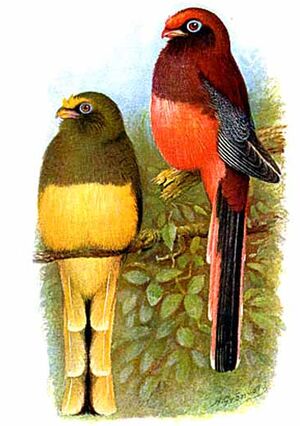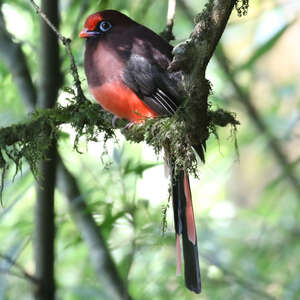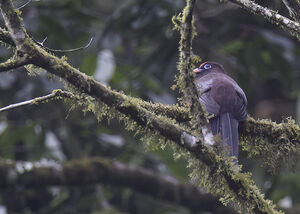Ward's Trogon
Harpactes wardi - Trogon de Ward
Identification
Scottish ornithologist Norman Boyd Kinnear (1882-1957) discovered Ward's Trogon in 1927 in northern Burma, and paid homage to explorer and botanist Frank Kingdon Ward (1885-1958), who loved Asia and was still climbing altitudes of 3300 metres at over 68 years of age! The term extraordinary is an understatement for describing Ward's Trogon; one can speak of dimorphism amongst birds, but here the difference is total and we almost have two separate birds. They are part of the large trogon family, measuring 35-38 cm long and weighing 115-120 grams. The male has a red tip for its beak and a grey base, and vibrissae sticking out from either side of the beak. Its forehead is red-vermilion, its eye rim and frontal eye-stripe are black which contrast with a large blue orbital circle, and the iris is dark brown. The crown, nape, back of the eye and scapulars are a greyish-violetbrown colour, which can vary in its tones depending on age or the individual bird. The chest, mantle, back and scapulars have the same greyish-violetbrown shade, and the belly is red with a rosy hue on the lower side. The black coverts are striped with thin white horizontal lines, and the black remiges are bordered with white on the notching edge. The three lower rectrices of Ward's Trogon have one unique trait amongst the trogonidae family - they are pink with a small grey base! When spread, they show the upper rectrices to be black, so from the back the bird appears to have a black tail. The companion of Ward's Trogon did not want to be outdone; while females are often less noticeable in most trogons, Madam Trogon was not to be outshone and sported a brightly different livery.The beak is light yellow with a black culmen, the base of the beak is light gray-brown, the forehead is gold yellow and the eyebrow is fawn, the same black enclosure around the eye is still there marking the blue orbital circle, the iris is always dark brown. The cap and nape are light olive-brown, the throat slightly blackened, the mantle, back, scapulars and chest are of a color oscillating between olive-brown and pastel purple, this very fine and nuance coloration will depend to a large extent on the ambient brightness. The belly is yellow, the brown coverts are vermiculated with very close beige-fawn wavy patterns, the remiges are dark brown and bordered with white at the emarginations. The lower rectrices are at least as original as those of its companion, madame has replaced the pink with a layer of yellow and kept the brown bases, the upper rectrices are dark brown, appearing almost black with some lights. We can notice at this stage of the description that we have to do with the single trogon that has rectrices of a different color from white or black and that has chosen two totally different colors, pink and yellow, according to sex. Supreme coquetry, the light pink-brown tarsi ! Young males have not been observed, young females have a paler yellow color in the belly, the mantle and back are light brown, the yellow mark on the forehead is not yet visible.
Subspecific information monotypic species
Foreign names
- Trogon de Ward,
- Trogón de Ward,
- republicano-do-himalaia,
- Rosenschwanztrogon,
- Ward-malájtrogon,
- Wards Trogon,
- Trogone di Ward,
- wardtrogon,
- Rosenbryntrogon,
- dravčík hnedý,
- trogon Wardův,
- Stor Trogon,
- isotrogoni,
- trogon de Ward,
- sędzioł assamski,
- sārtastes trogons,
- Розовохвостый азиатский трогон,
- ビルマキヌバネドリ,
- 红腹咬鹃,
- rosentrogon,
- 紅腹咬鵑,
Voice song and call
Habitat
Ward's Trogon frequents the lower levels of broadleaf forests often with evergreen foliage, often seen in the middle of subtropical forests of Quercus (oak is part of this family), Castanopsis, trees typical of Southeast Asia, and also bamboo groves. Even though it has been sometimes seen at 300 m of altitude, it will frequently reach from 1,500 to 3,200 m and it is often at this altitude that one has the best chance of seeing it.
Behaviour character trait
He is a sedentary bird, descending to lower altitude in winter.
Dietfeeding habits
Mainly insectivorous (moths, all kinds of stick insects, caterpillars, orthopterans), Ward's Trogon will also enrich its diet with berries and seeds; again, knowledge about its diet is very scarce.
Reproduction nesting
Probably in breeding condition in March-April. There are no records of nesting and reproduction of Ward's Trogon!
Geographic range
Birdlife reffers to regions where Ward's Trogon can be found as Endemic Bird Areas of the World or EBA. The targeted region is known as Eastern Himalayas, the far east of the Himalayan range. The bird has been seen in the past in Tonkin on the Fan Si Pan plateau in the northwest of Vietnam and near the Laotian border, but it is not observed anymore; different wars have left their mark. The same applies in China, in the province of Yunnan where it has become very rare; 3 individuals were spotted for the last time in 1973! Bhutan is one of its last sanctuaries and the population seems to be fairly stable in the country; the Thrumshingla National Park in the center of the land of happiness is known for its Ward's Trogon. In India, it can be found in the state of Arunachal Pradesh in the far east of the Indian Union and in the north of Myanmar in the district of Myitkina.
Threats - protection
IUCN conservation status
concern
in the Wild
threatened
evaluated
NT's distribution range may be what has partly preserved it; while it has probably disappeared from Indochina and certainly from China, pockets of resistance still remain, with Myanmar, Arunachal Pradesh in India, and of course Bhutan, preserving some colonies, meaning that the species is still not vulnerable according to Birdlife and IUCN. Deforestation, population expansion, and human stupidity are the relentless foes of one of the most remarkable birds our planet hosts. Ward's Trogon enjoys high altitudes and is difficult to observe, living at the gates of Asian wisdom; let's hope it finds protection in the highest peaks of the Himalayas, so that we can admire it for as long as possible!
Sources of information
- IOC World Bird List (v15.1), Gill, F and D Donsker (Eds). 2025-12-07.
- A Natural history of the Trogonidae, Joseph M.Forshaw Albert Earl Gilbert
- A Field Guide to the Birds of the Indian Subcontinent, Krys Kazmierczak, Ber Van Perlo
- Vol. 6 - Handbook of the Birds of the World, Josep del Hoyo-Andrew Elliott-Jordi Sargatal
- xeno-canto, Sharing bird sounds from around the world,
- ARKive, Christopher Parsons
- Avibase, Lepage Denis
- BirdLife International, BirdLife International
- HBW Alive,
- Wikipédia, Wikipedia, The Free Encyclopedia
- The internet Bird Collection,
- Oriental Bird Club,
Other sources of interest
 Specification sheet created on
02/08/2023 by Anne et Gabriel Leboff
Specification sheet created on
02/08/2023 by Anne et Gabriel LeboffTranslation by AI Oiseaux.net
© 1996-2025 Oiseaux.net
- Accipitriformes
- Aegotheliformes
- Anseriformes
- Apodiformes
- Apterygiformes
- Bucerotiformes
- Caprimulgiformes
- Cariamiformes
- Casuariiformes
- Charadriiformes
- Ciconiiformes
- Coliiformes
- Columbiformes
- Coraciiformes
- Cuculiformes
- Eurypygiformes
- Falconiformes
- Galliformes
- Gaviiformes
- Gruiformes
- Leptosomiformes
- Mesitornithiformes
- Musophagiformes
- Nyctibiiformes
- Opisthocomiformes
- Otidiformes
- Passeriformes
- Pelecaniformes
- Phaethontiformes
- Phoenicopteriformes
- Piciformes
- Podargiformes
- Podicipediformes
- Procellariiformes
- Psittaciformes
- Pterocliformes
- Rheiformes
- Sphenisciformes
- Steatornithiformes
- Strigiformes
- Struthioniformes
- Suliformes
- Tinamiformes
- Trogoniformes






